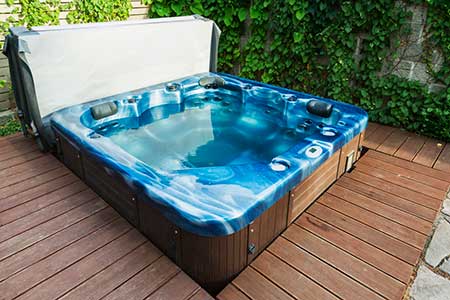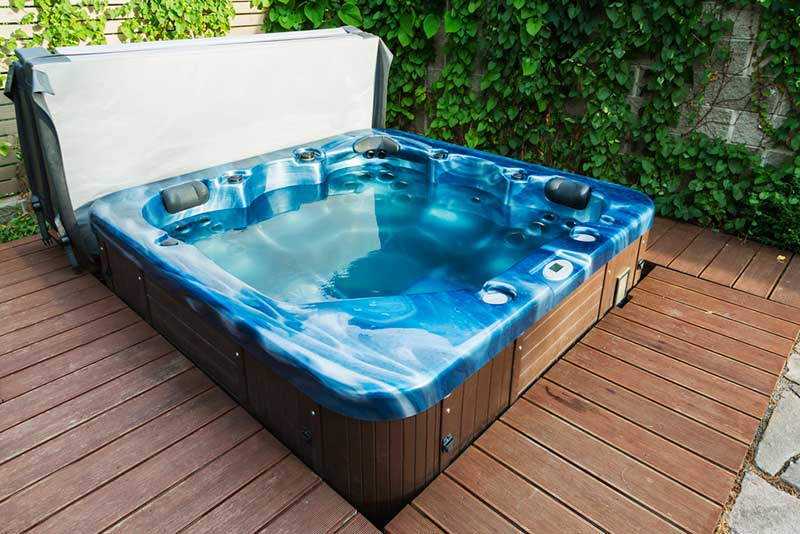
If your hot tub has been sitting in your garden unused all winter, you may be wondering how to clean it when the spring comes around and you want to enjoy the bubbly water once more. After months out of use, your spa is likely to have accumulated some grime and dirt which requires removal.
So, how do you clean a hot tub that’s been sitting unused? First, you need to check and clean the hot tub’s filters, then drain the water and thoroughly clean the hot tub shell. This is followed by refilling and flushing before finally draining and refilling one last time.
Although it seems a time-consuming process to follow all of these steps when it comes to bringing your neglected hot tub back into use, it’s important to do so if you want to ensure that your spa is hygienic and safe for use. Let’s take a closer look at all of the necessary steps to clean your tub to bring it back to optimal condition so that you can enjoy your relaxing bathing experience as quickly as possible.
What is the Process of Cleaning a Neglected Hot Tub?
When your hot tub is clean and hygienic, you can enjoy relaxing bathing time with no worries about potential health concerns or safety hazards. However, if your spa hasn’t been cleaned for some time, it’s going to require some attention before you can safely get into it again.
If you neglect to clean your hot tub thoroughly after a longer period of inactivity, you could develop unpleasant infections due to bacteria and germs in the water. This is why cleaning is so important.
When you use a spa, you naturally shed skin cells, as well as natural oils in the form of sweat, lotions, makeup and minute dirt particles. Hopefully, this debris will be captured by the pool’s filters, but they can only capture the debris inside the column of water. Anything that floats upwards will usually settle as a layer on the surface and remain there.
This layer is a breeding ground for bacteria since they thrive in damp and warm conditions. The chemicals you use in your hot tub will kill most of these bacteria, but some will survive and will be carried through the filter due to their tiny size, and will often become lodged inside the heating system’s pipes. When the pump hasn’t been running for a while, this bacteria can start to multiply. Without proper cleansing before the next use of the tub, the bacteria can get into the water and cause skin rashes and other medical conditions.
Tubs that are left unused for more than a couple of weeks are likely to experience a build-up of contaminants. It won’t take too long for hot tub water to spoil if the tub has sat for several weeks without sanitiszation or filtering. Even in moderate temperatures, you can only expect your spa water to remain fresh for around 2 weeks, and that’s only if the tub is tightly covered.
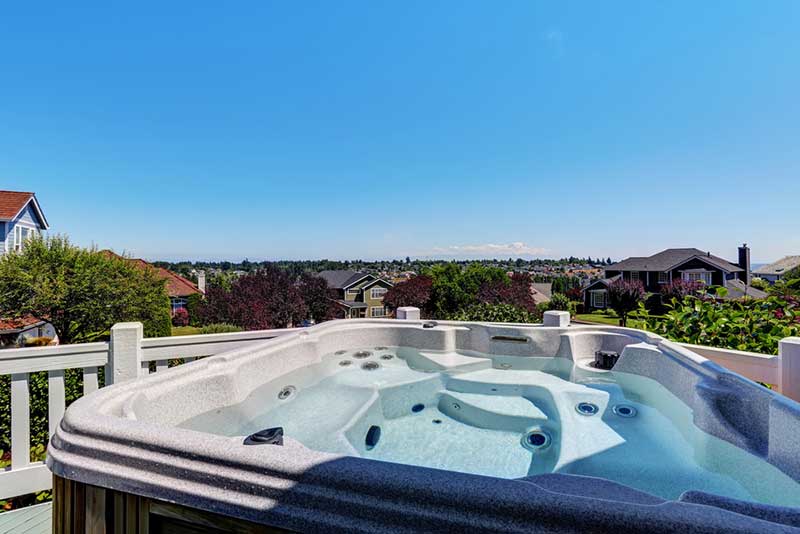
After a couple of weeks, the spa water will start to develop bacteria and algae, even if the tub is protected from light under a dark cover. It will start to grow bacterial colonies or biofilm that will need to be thoroughly removed before you can even think about getting back into the bubbly water.
This is why it’s so important to learn the correct method and procedure to clean your hot tub after it has remained untouched for some time. Even though it may have growth of bacteria and biofilm on its interior surfaces, you can clean it thoroughly by following just a few easy steps.
Check the filters – Check the filters to determine whether they need to be cleaned or replaced. Once this has been done, you need to ensure that all of the water has been completely drained away.
If you need a new filter Amazon carries a good selection on this page.
Clean the shell – The next stage involves cleaning the interior and exterior of the tub using a proprietary hot tub cleaner and clean fresh water from your hose. Take your time with this and make sure that you remove any stains, bacteria growth or algae from all of the difficult corners in the hot tub. Particularly check around jets and around the water line.
Flush to the hot tub – Next, you need to flush or purge the hot tub. Fill the hot tub with water again and add a special flushing solution to the water. Run the jest for the amount of time that it says on the instructions. This will flush out all of the accumulated gunk from inside the hot tub’s pipework into the water.
Drain and refill – Finally, drain the tub one more time and refill it. Don’t forget while you’re following this cleaning process to clean the cover, steps and any accessories that you plan to use in the tub. This will ensure that everything is ready for use once more and won’t cause you any unwanted problems when you decide to get into the tub again.
The longer you can spend cleaning and the more thorough you are the fewer problems you will have with dirty water further along the line. It’s worth taking time over the cleaning process in the long run.
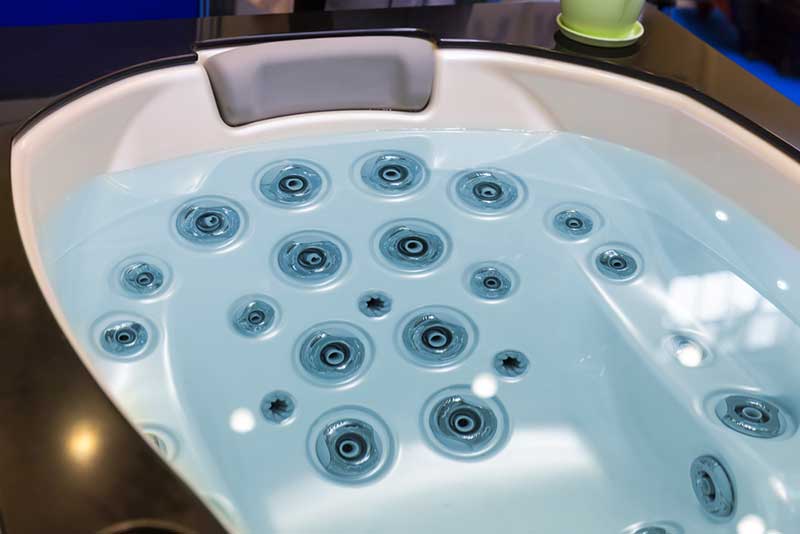
Let’s have a closer look at the process in more detail:
How do I Test the hot tub’s pump and Filter System?
Testing your tub’s filter system is the first step in the cleaning process, and it must be completed before you even begin thinking about physically cleaning the inside of the tub. You need to check that the filter and spa pump are operating correctly.
You can do this by adding water when necessary so that its level reaches up to the middle of the skimmer. The water should always cover the spa filter, although you may need to replace it with a brand new filter cartridge.
You can find out more details about how to check and clean the filters in my post here.
The next step is to switch the power on at the circuit breaker before opening up the hot tub cabinet to locate the spa equipment. Make sure that no GFCI outlets have popped. If they have, you need to reset them. Power up the hot tub pack, checking that every valve is properly open before after and before the pump. Check to make sure that no water is leaking underneath the spa.
Switch on the tub and ensure that the pump is running on a low speed. If this works well, run it briefly at a high speed too. This will ensure that no debris remains in the pipes and that any gunk has been properly dislodged. Some hot tubs feature two pumps – a jet pump and a circulation pump. Don’t forget that you need to test both to ensure they’ll remain fully operational even when the hot tub has been drained and cleaned.
How Do I Drain And Clean The Tub?
If you’re wondering how you get started with cleaning your tub of all the grime and dirt that’s built up while your tub has been sitting unused, the first step is to drain the water completely. The water may appear to be in relatively good condition, with no algae growth or biofilm. If this is the case, you may wish to skip the step of draining the tub, but it’s advisable to do it to ensure the safety and hygiene of the water.
To drain the tub, you first need to locate its drainage port or hose. Some tubs have a small drainage port located at the bottom of the cabinet. Some others feature a short hose right at the bottom of the tub. Either pull the hose out or connect the hose to the tub then allow the water to drain out. It’s even possible to use a pump if you wish to finish the process more rapidly. Ensure the tub has been switched off first, though, before you attempt to drain the tub.
Once the water is removed from the tub, it’s time to clean the surfaces of the tub. Use your garden hose to spray water directly into the skimmer or into the jets. When you do this, the build-up of dirt and grime will then be loosened effectively. Remember, though, to take extra care not to spray water onto the spa pack or spa equipment as this could cause damage.
Some people choose to scour their hot tub using a pressure washer to ensure that everything is removed fully. While this may be suitable for your tub, it’s important to check that your spa has been designed to withstand such a powerful cleaning method. Not all can, and you don’t want to cause any damage.
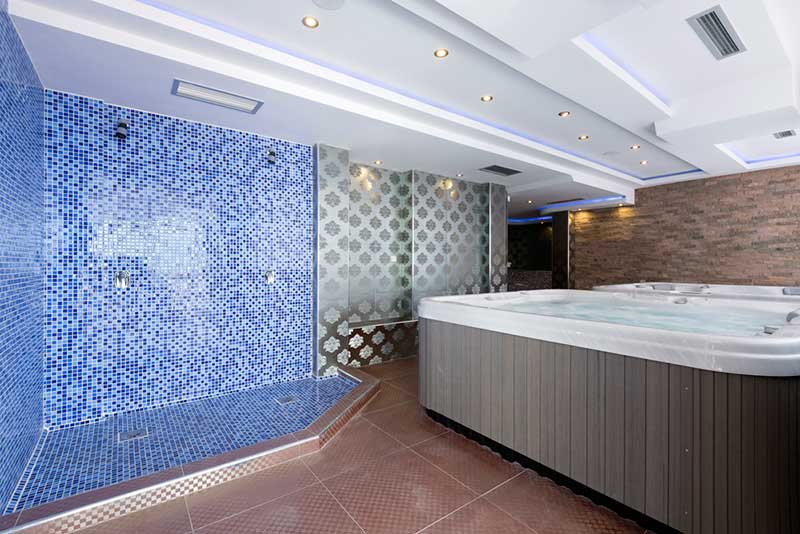
Remember that the shell of your hot tub is just as likely to develop a build-up of algae and limescale as the interior surfaces, and it’s also likely to develop structural problems. Make sure you clean the outer shell of your tub too, making certain to check for any scratches and cracks as you do so. Also, make sure that any cleaning solution that you’ve used to clean the tub is fully rinsed away. You don’t want to allow cleaning solutions to cake up on your tub’s surfaces as this too can cause damage at a later date.
How Do I Purge And Refill The Tub?
Once your hot tub has been fully drained and the inside surfaces thoroughly cleaned, it’s time to progress to purging the tub. When you purge your spa, you add special chemicals to remove the biofilm that builds up and persists inside the tub’s pipework. It’s absolutely essential to complete this step of the process since sometimes it’s impossible to properly clean the pipes by just draining the water out of the tub.
The chemicals that are used to purge the tub are designed to completely remove the biofilm, mineral deposits, oils and other organic build-up that accumulates in your hot tub over time. Make sure you check the label on the chemicals’ packaging for directions and follow them carefully to ensure that the task is done properly.
First, you’ll need to refill the tub with clean, fresh water. This water isn’t for bathing in, it’s for adding the chemicals that will clean the spa. Once the tub is full, you should switch on the spa pump so that it’s operational. Only then can you add the chemicals to the water. Shortly afterwards, you’ll see that brown foam begins to rise up to the surface of the water. Although this looks unappealing, it’s an essential part of the process since it means that the dirt and build-up is being effectively removed and eradicated. Switch both the pump and the blower on to combat any remaining bacteria.
Once this step is complete, you need to drain the hot tub one more time before refilling it ready for use. Use a hose or a rag to get rid of the dirt which has collected at the top of the hot tub. As the water level drops when you drain the tub (following the procedure outlined earlier in this article), keep cleaning the surface of the tub with the rag or hose.
Once the tub has been completely drained of all water, get a sponge and use it to remove any water droplets that remain inside the spa. This gets rid of any remaining gunk including any bacteria that was pushed out of the spa lines by the chemicals that you used to purge the tub.
While you may now be desperate to jump back in your hot tub for a relaxing soak once more, you still need to wait to allow all of the surfaces of your tub to thoroughly dry before you refill it and add chemicals ready for use again. Once the tub’s surfaces are dry, you can fully examine the entire set up to check for any mould damage, mildew or weak spots that could use dampness as a disguise to avoid being detected. Once this process is complete, it’s time to refill the tub for the final time with fresh, clean water.
If you would like to know more about how to set up your hot tub’s chemicals and how to maintain it check out my post here.
Using your garden hose, refill the tub with clean water. Once it has reached a point beyond the minimum fill line, test the conditions of the water using a test stick and then add the necessary hot tub chemicals to balance the pH level, alkalinity and calcium harness. Finally, shock the water with a shock treatment, following the instructions on the label carefully to ensure that the spa is safe and hygienic to use.
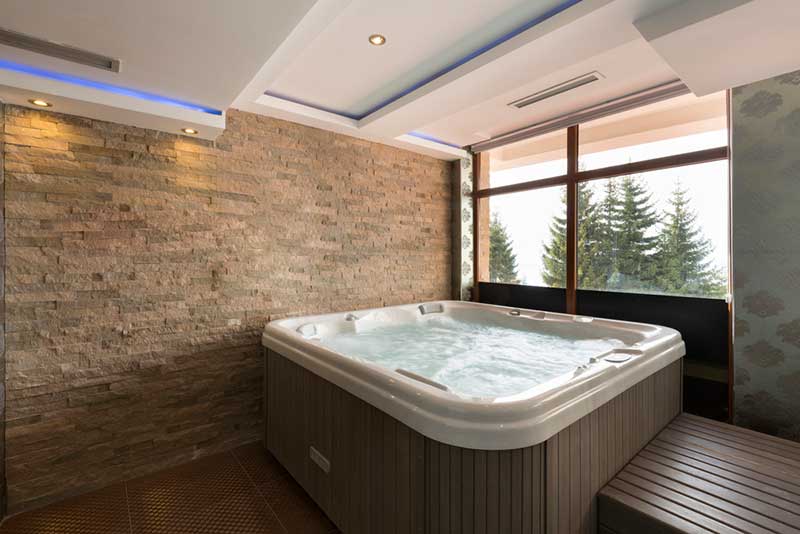
Are There Any Additional Cleaning Steps?
Bear in mind that the hot tub’s steps and cover should be properly cleaned as part of the process to ensure the clean is thorough and comprehensive. Although it may seem that the steps can be overlooked during a clean, bear in mind that build up can also accumulate on them, particularly if you haven’t cleaned them for some time.
Dirt and leaves can also accumulate on the cover of your hot tub, and this runs the risk of the debris falling into the water and contaminating your bathing water. Therefore, you should take the time to get your garden hose and spray the cover to remove the collected dirt. If there is a lot of debris on the cover, or if the dirt that has gathered on it is especially difficult to remove with just water, it’s possible to use lukewarm water together with a little liquid detergent and a sponge.
A final step before using your hot tub again is to check the electrics, rigging and wiring, to make sure that there are no problems that could prove damaging or dangerous when the tub is in use once more. If any problems are detected, they must be rectified before you even think about using the hot tub. Remember, though, never to try to fix any problems with your spa’s electrical system yourself unless you’re a qualified electrician. A professional should be tackling this job for your safety and peace of mind.
Related Questions
What can happen if I don’t clean my hot tub properly? If you don’t thoroughly clean your hot tub after a long period of inactivity, if you don’t have a regular draining and cleaning schedule or if you don’t use the right balance of chemicals to keep the water in the tub clean and safe for use, you could develop skin problems like hot tub folliculitis which is irritating, itchy and unpleasant. You could even develop more serious medical problems such as Legionnaire’s Disease which, in some cases, can even prove to be fatal. With this in mind, it’s easy to see why cleaning your tub properly is so important.
How do I keep my hot tub safe for use on a regular basis? The key to keeping your hot tub safe and ready for use is to make sure that the water is hygienic, sanitized and bacteria free. You can do this by regularly testing the condition of the water using test strips that can be bought and used yourself.
These strips will tell you whether the pH balance of the water is correct and whether the level of chemicals is optimal. You can then use bromine, chlorine or other suitable hot tub chemicals to sanitise the water so that it’s safe for use. You can also use shock treatments whenever necessary to ensure that the water is free of any potentially harmful contaminants or germs.

